
Members of Rockwood School District’s “challenge committee” support children reading sexually graphic books; district introduces plan to train teachers to use students’ “preferred name and pronouns”
Incidents
The Rockwood School District formed a committee to review the children’s book It Feels Good to Be Yourself, a book that is based in gender ideology. However, the book reportedly remains in 17 of the district’s school libraries. Sixteen of those are in libraries of elementary schools. On March 29, 2022, the news outlet What’s Going On reported that “the book was formally challenged in December of 2021” but “the district still hasn’t made a decision.” The news outlet reached out to Assistant Superintendent Shelley Willott on why the book is still in the district’s libraries. She explained:
As an employee of the district, my role is to follow Regulation 6241. The regulation states “Access to challenged material shall not be restricted during the reconsideration process.” The committee’s decision, along with their rationale, will be included in the final report that will be submitted to the Board of Education.”
KSDK reported that the committee reviewing the book is called a “challenge committee” and includes “librarians, teachers, administrators, and parents.” What’s Going On reported that the book contained the following phrases:
- Alex is both boy and girl. This is Alex’s gender.
- JJ is neither a boy or a girl. This is JJ’s gender identity.
- Alex and JJ are both non-binary.

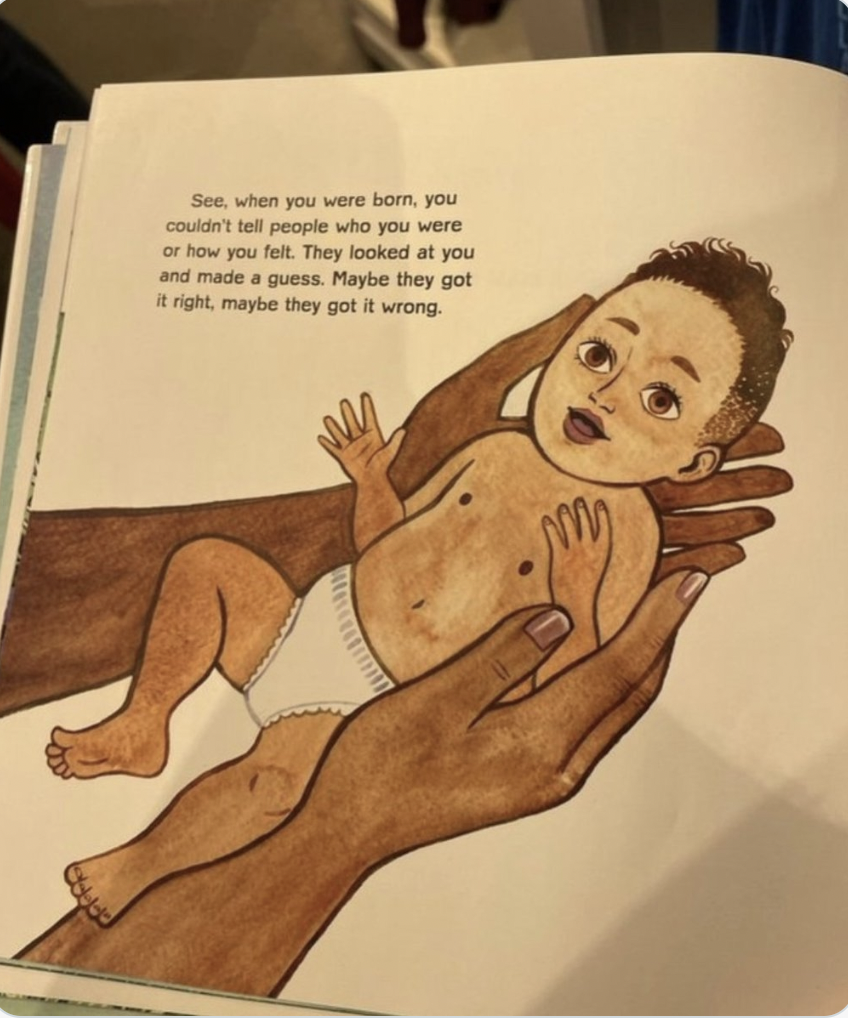
The school district published the committee’s report online explaining the thoughts of the committee members and their decision. The report provides reviews that have been given for the book. These reviews include comments such as the author “explains the concepts of cisgender, transgender, and non-binary in simple, accessible language” in the book and that “illustrations feature gender-expansive individuals going to school, making art, and spending time with family, normalizing the expressions.”
The committee discussed the book for the first time on December 21, 2021. Committee members provided the following “comments on the value of this material” in that meeting:
- The author does a good job of taking a complex topic for children and explaining it with simplicity.
- There is a great deal of diversity in the book–skin tone, body types, etc.
- This book serves a purpose for students who need mirrors on this topic.
- The book is welcoming as a whole.
- The illustrations are high quality and appealing to kids.
- This book encourages dialogue and discussion that is supported by a glossary and resources.
- The book takes away the stereotypes of boy vs. girl.
- The book provides a jumping start to talk with kids.
- The challenger said something about private body parts. This book does not discuss genitalia or body parts at all. It sticks to gender identity, not sexual orientation
The committee members decided in this meeting that they “did not want to remove the book, but weren’t sure what the final decision should be.” The committee members “wanted time to process their thoughts and seek opinions from additional elementary staff who work with students including counselors and administrators.” On March 15, 2022, the committee came together again and provided more “comments on the value” of the book. The following are some of the comments the committee provided:
- The discussion from the previous meeting was reviewed. The group verified that no one wanted to ban the book. The discussion is what do we do with the book and where do we put the book.
- Three elementary counselors were asked for their thoughts on the book, and they wanted to make sure students had access to the book.
- Two elementary administrators were asked for their thoughts on the book, and they felt that kids could have supported conversation with the right adults if the book was available in the library and a student chose to check it out.
- It was shared that in some buildings, kindergartners can check three books out at a time, but only take one home so it’s possible this would be the book not going home and parents not seeing it.
- Others said they wanted it available, but they wanted to make sure students had adult support.
The committee members then discussed moving the book to the “counseling office” as a middle ground. In this discussion, the ACLU and the American Library Association were discussed in terms of giving the school district bad publicity for moving the book to the “counseling office.” The following were some of the comments noted from the discussion with committee members:
- How will this look in terms of the ACLU? The American Library association will say it is censorship. Not sure what the ACLU will say or where they will fall.
- I don’t love that option. Can I live with it, maybe, but I really don’t like it. I have a kindergartner and a 4th grader. The 4th grader read it and just kinda said ok. The kindergartner read it, said I’m a boy and then went to play. There is nothing wrong with letting them read it.
- The book should be in general circulation, but put a flag or notification on it. Not judging with my situation, but thinking about kids who don’t have the support.
- More ideal to have accessible in general circulation.
- Kids might not know to go search for something like that. But the kids who need it, should have access to it.
The committee then considered a second proposal: “Keep the book in circulation, note on the book for
librarians to follow up with teacher, parent or counselor. Parents have the option to see what their child is reading and can request a daily email of what their child has checked out. They can also put a block on the book.” The following are some of the comments committee members had on the idea:
- What stops a child from picking up the book and just looking at it and not checking it out?
- It is censorship to put the book behind the desk or in the counselor’s office.
- Most parents are not looking over their kids shoulder to know what they are doing online. Why should we take that approach with books?
- It is censorship and it’s a huge red flag if we put it behind a counter.
- I think them picking up the book and thumbing through it is not going to hurt anything.
The committee members were then asked again “if they all could live with the second proposal.” The following are comments made by some members of the committee:
- The message is to accept people for who they are.
- Genuinely, this is a positive book.
- Realistically it is a harmless book, but has a controversial subject.
- We should keep the book as is and follow up after checkout as needed.
- This book was written for a primary school audience.
The committee members were then asked “one final time whether they could live with the second proposal.” The following notes were provided:
- The majority of the committee members reached consensus and agreed to recommend that the book be retained in the library. A note will be placed on the book for librarians to follow up with the teacher, parent or counselor. Parents have the option to see what their child is reading and can request a daily email of what their child has checked out. They can also put a block on the book.
- One committee member did not indicate that they could live with this recommendation.
The committee then made the following decision: “The book will remain in circulation, but will have a flag in Destiny alerting the librarian to follow up with the teacher, counselor or parent to ensure a trusted adult is aware that the child may have questions or want to discuss the book.”
The school district also had a challenge committee review for the book Gender Queer. The book is known for graphic illustrations of sex acts. The committee report for this book stated that the committee members chose “to retain the book as a library book without restriction.” Members of the committee had the following comments in the discussion of this book:
- This book serves as a mirror or a window for some of our students. The feeling of being a different gender is unique.
- In order for something to be considered pornography its sole purpose has to be to pleasure and excite sexually. This book was not meant to be erotic or entertaining, but to be used as information. It was not used to arouse. It does not meet the criteria of pornography. These are normal thoughts of sexuality for teenagers.
- The book was an encouraging and uplifting account on what it means to not understand who you are or your place in the area of LGBTQ. It offers important information on diversity. It is difficult to find these types of books. It is extremely well done, literary, intelligent and honest. It is meant to be a guide for people trying to find themselves.
- A committee member shared that gender non-conforming adolescence is at a high risk of suicide. It is an incredible contribution to the library. It is a wonderful choice for those who are non-binary.
- The pictures are not used for arousal. The symbols and literary ideas would speak to a lot of students. I’m ok with my kids reading it, and they are freshman and college level. I think it would be too dangerous to remove from the library.
- I found this book very powerful, and I am thankful that it’s available. I have empathy for those who may be struggling with these concerns. I shared this book with my junior. It’s powerful, and it touches on emotions and mental health. This book may help someone contemplating suicide so that they may not feel alone with their struggles. This book is helpful.
- I have a junior with language disabilities. I look at the book and think that if my child had these questions about themselves, I would want them to read it.
- Usually when a book is being talked about among the community, kids check it out, and that has not been the case with this one.
- The images are shocking, but only shocking when taken out of context. When it is put into context with the emotion being described, it’s not the same. It’s not just an image. It’s about a person going through an emotional struggle. It is not meant for arousal.
- The pictures are consensual. I Know Why the Cage Bird Sings is not a graphic novel, but has a vivid description of non-consensual sex. It’s because it’s visual and that’s what is making parents upset. This is consensual and exploratory between two adults.
- I do not find these images shocking. There is an undercurrent that this is abnormal and deviant.
The school district had another challenge committee report for the book All Boys Aren’t Blue. This book is known for graphically depicting a sexual encounter between two men. The committee report for the book stated that the committee members chose “to retain the book as a library book without restriction.” One committee member made the following statement regarding the book:
I loved the Book! My children are going to be encouraged to read it. Even though I did not experience any of these things in my life, I would encourage every teen to read this book because of the insight into somebody else’s life and for those who did experience it to give them a voice. Those who lived this may need to feel seen and not alone. Suicide rates are currently so high because people feel alone.
The school district has a strategic plan called “The Way Forward.” One goal area for this strategic plan is titled “Universal Equity, Opportunity, Access.” The strategic plan requires three multiple part objectives to achieve this goal that include:
- Utilize a SYSTEMATIC APPROACH to increase student equity, access and opportunity.
- Adopt an educational equity statement for the district.
- Develop a multi-tiered system of support that provides differentiated levels of resources based upon academic, behavioral, social emotional and physical needs.
- Explore opportunities to support inclusive school environments for all students.
- Form a subcommittee within Rockwood Learning Council to engage teacher leaders and administrators in the areas of access, opportunity, and equity.
- Conduct an equity audit.
- Provide a CULTURALLY RESPONSIVE ENVIRONMENT for all students.
- Develop a framework, common language, and supports for teachers, staff and students.
- Provide employee training on culturally competent and responsive teaching strategies and equity for all identities.
- Empower all students to design PERSONALIZED PATHWAYS for their future.
- Develop a comprehensive K-12 college and career readiness plan.
- Increase enrollment of students from underrepresented populations in advanced coursework and expand supports for their success.
- Create multiple pathways to a high school diploma, providing students with personalized educational programming.
The school district also has a “Rockwood Equity Parent Advisory Council.” The school district’s website states:
The Rockwood School District is seeking parents interested in serving on a diversity, equity, and inclusion advisory council through the Office of Educational Equity and Diversity. The Rockwood Equity Parent Advisory Council (REPAC) will ensure the Rockwood School District stays on course with the universal equity, opportunity and access goals outlined in The Way Forward, the Rockwood strategic plan. REPAC will promote, support and inform the school community of DEI resources, initiatives, and opportunities.
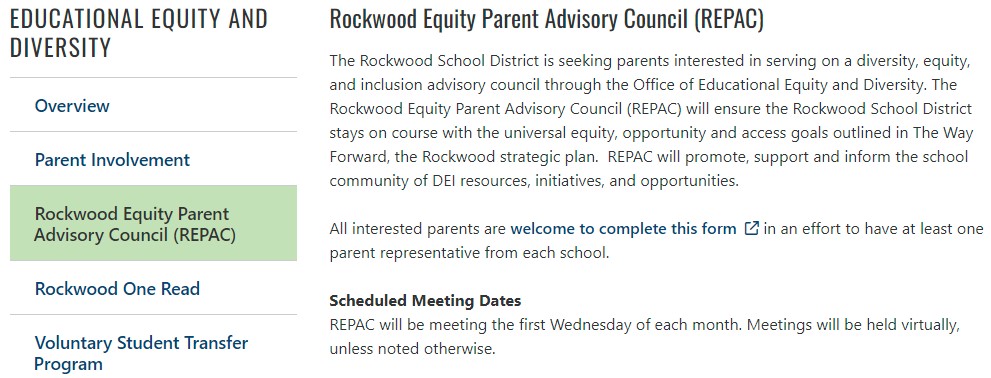
Parents can fill out a form to apply to this equity council. The form appears to show that there are five subcommittees of this council. These subcommittees are “Equity Audit/Data Committee,” “Culturally Responsive Teaching/Professional Development Committee,” “Diverse Curriculum Committee,” “Equity For All Identities (Gender, English Language Learners, Ability, LGBTQ+),” and “Recruiting, Hiring, and Retaining a Diverse Staff Committee.” The phrase “culturally responsive teaching” is often used to describe a method of teaching that includes the race and ethnicity of students as part of the lessons taught in classrooms.
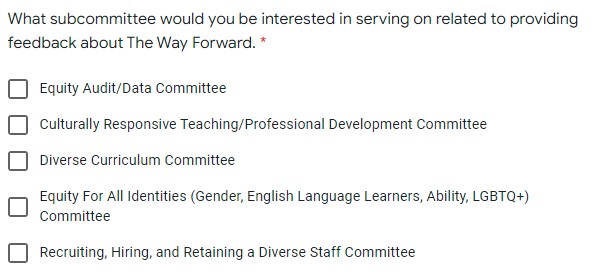
In a slide from a meeting that the equity council had on March 2, 2022, subcommittees of the equity council shared their action plans. The “Culturally Responsive Teaching/Professional Development Committee” shared an action plan that consisted of short term and long term objectives. These objectives included:
- Short Term Objectives:
- Facilitate teacher awareness about student’s diverse identities and experiences including (but not limited to): Religion, Cultural, Gender/Sexuality, Racial, Ability.
- Enlist building champions to help identify and define the groups within the district that our educators need to understand better. GAP analysis.
- Create a reading and resource list about these identities. Create a professional development video series or podcast that would help educators understand the diverse identities within the district and the challenges they face that educators can handle.
- Conduct training programs that help educators understand how their own biases inform their teaching and response to issues.
- Evaluate the current trainings and resources offered to educators surrounding DEI.
- Identify and vet training programs that will help educators to develop an awareness of their own biases without ostracizing reluctant teachers and parents.
- Focus on training building champions.
- Help educators understand how to handle emergent classroom issues and become culturally responsive and trauma informed.
- Build or model a program (possibly based in the restorative justice model) for dealing with student issues and conflicts centered on identities.
- Train school counselors to help host these conversation.
- Help educators move from “discipline and punishment” to “learning and growth” with concrete steps and tactics.
- Help administrators create plans for dealing with emergent issues both internally within the school building and externally in communications with the community.
- Facilitate teacher awareness about student’s diverse identities and experiences including (but not limited to): Religion, Cultural, Gender/Sexuality, Racial, Ability.
- Long Term Objectives:
- Help educators create and facilitate a culture of open communication around DEI competencies by establishing a district wide common language and definitions to help educators understand DEI issues and be able to engage in productive conversations.
- Create a document that defines, district wide, these specific terms (might be a short term goal).
- Create networking and support opportunities for building champions so they can help their building as well as stay unified with the district’s DEI goals.
- Create a slack or other communication channel so building champions can communicate and share best practices as needed.
- Host events for Building champions to allow them to network and gain support from each other in real time.
- Develop a library of DEI training materials that can be facilitated by building DEI advocates as needed.
- Gather best practices currently in place as well as materials from past trainings.
- Centrally locate the materials online where they can be searched and easily accessed.
- Provide connections to in district people who can train and troubleshoot issues as they occur.
- Help educators create and facilitate a culture of open communication around DEI competencies by establishing a district wide common language and definitions to help educators understand DEI issues and be able to engage in productive conversations.
The action plan for the “Diverse Curriculum Committee” discusses implementing “diversity, equity, and inclusion” into the curriculum taught to students. This action plan also announces an intention to create a plan for teachers when they “face community pushback” for implementing political ideologies into the material they teach children. The following are the action plan’s objectives:
- Short Term Objectives:
- Formally defining what “diverse curriculum” means to Rockwood/REPAC and sharing with all involved in curriculum decisions.
- Include an action plan for when teachers make choices according to the definition but face community pushback.
- Audit/inventory current curriculum and processes for diversity, equity & inclusion.
- Identify and collaborate with the appropriate Rockwood administrator to gather information about how diversity, equity and inclusion are currently embedded in the curriculum and the plan to ensure DEI is embedded in the future.
- Understand curriculum process and timeline for change.
- Auditing for balance in everything (topics, trauma, represented groups, materials).
- Plan for transparency and oversight into curriculum and teaching materials.
- Identify what groups will represent parents, teachers, etc. (REPAC?)
- Create a training workshop for this parent group that includes background on processes, audit, etc.
- Revisiting communication so more parents are aware of what info is out there, what processes are out there, where to find it, etc. (Infographics?)
- Formally defining what “diverse curriculum” means to Rockwood/REPAC and sharing with all involved in curriculum decisions.
- Long Term Objectives:
- Create and share a Rockwood DEI Curriculum report including audit results, action areas, stats/figures about Rockwood demographics, value of DEI education, etc.
- Develop and share specific curriculum & learning goals based on the audit.
- Communicate action steps from the equity audit data specifically related to a plan for students below, at, and above grade level.
- Develop a plan to incorporate members of the larger St. Louis community to increase representation in everyday and bonus learning opportunities, including speakers, “career days”, college students, etc.
- Look for opportunities to tie into existing programs (PIE).
The action plan of the “Equity Audit/Data Committee” discusses how to implement an equity audit and equity surveys throughout the district. The following are the action plan’s objectives:
- Short Term Objectives:
- Learn how stakeholders feel about DEI in their buildings and the district.
- Survey all stakeholders (families, students, staff, alumni etc.) to glean information about how they think/feel about diversity, equity, and inclusion efforts in the district.
- Allow families and students to give feedback on what kind of SEL questions as part of survey when taken or prior to survey being given-QR code at mass gathering-back to school night/curriculum night.
- Have staff complete surveys via email or at a staff meeting. Having a QR code would be ideal.
- Review feedback and prioritize minority populations represented with after school activities or student groups.
- Learn how stakeholders feel about DEI in their buildings and the district.
- Long Term Objectives:
- When groups that have historically underrepresented are represented in the data that guides building objectives relating to DEI.
- Continue give bi-annual SEL survey that include DEI related questions ie. self identifiers, group identifiers, etc.
- External audit on what buildings have done historically and what they are doing now with DEI related data collected.
- When groups that have historically underrepresented are represented in the data that guides building objectives relating to DEI.
The action plan for the “Equity For All Identities” subcommittee discusses plans to allow students to pick their “preferred name and pronouns.” This includes “staff training on legalities of helping students identify as they prefer” along with middle and high school teachers “sharing their name and their pronoun, then continue with a ’round robin’ to have each student share their name and pronoun.”
The action plan also includes plans to establish affinity groups and to establish “a list of days of awareness,” with “Transgender Awareness Week” and “Transgender Day of Visibility” specifically mentioned. Affinity groups are segregated groups that separate people based on race, sexuality, and other identity characteristics. The following are the action plan’s objectives:
- Short Term Objectives:
- Preferred name and pronouns identified at the beginning of each school year.
- Staff training on legalities of helping students identify as they prefer.
- All Levels – “About Me” form completed by students to capture preferred names with an understanding that approval is needed by parents for staff to call the student by that name. “About My Child” form completed by parents and shared with staff which will include an update to the “nicknames” section of IC.
- Middle and high school – teachers start with sharing their name and their pronoun, then continue with a “round robin” to have each student share their name and pronoun. Also helps with pronouncing names that the teacher may not know how to pronounce.
- Pronouns of each staff member posted outside their door.
- Provide safe space for religious and ethnic needs.
- Signs to not make strong smelling foods in staff break rooms during Ramadan.
- Provide alternative classrooms during lunch (e.g. room helper) for those students fasting during Ramadan.
- Recognition of non-Christain holidays.
- Student affinity groups at each middle and high school.
- Developed for Black students, females, gender/sexuality, religious/ethnic groups consistently across schools. Include allies.
- Develop a list of days of awareness to provide to schools including but not limited to Transgender Awareness Week (November 13-19) and Transgender Day of Visibility (March 31) and Black History Month at each school.
- Give staff examples of ways to celebrate these days – bulletin board, announcement, activity/guest speaker.
- Invite parents district-wide to share their celebrations with Dr. Grace to get shared throughout the schools.
- Preferred name and pronouns identified at the beginning of each school year.
The action plan of the “Recruiting, Hiring, and Retaining a Diverse Staff Committee” discusses specifically hiring “diverse staff” and using affinity groups to “support DEI initiatives.” The following are the action plan’s objectives:
- Short Term Objectives:
- Hiring: Understand the current hiring practices diverse staff.
- Get data from the equity audit and data of misc group.
- Obtain the baseline of current Rockwood Staff.
- Identify the recruitment process for hiring practices.
- Identify the actual recruiters in the hiring process.
- Talent Retention: Create an environment of inclusion.
- Support and expand affinity groups to support DEI initiatives – establish parent champion.
- Letting current staff know / update REPAC’s positive involvement in the talent retention goals.
- Recruitment Diverse Staff.
- Collect and obtain equity goal statistics to identify the baseline to create a quantifiable and measurable goal to meet expectations.
- Hiring: Understand the current hiring practices diverse staff.
- Long Term Objectives:
- Talent Retention: Improve district reputation- Improve the organizational leadership chart at the administration.
- Getting the message out to staff- Communication and execute plan to the public about the positive impact of a diverse staff.
- Recruitment: Form relationships with colleges/universities that have diverse student bodies.
- Target diverse institutions to increase the probability for a diverse recruitment pool by:
- Creating Ambassadors to join the HR contact in touring university recruitment fairs.
- Attend career fairs at the universities.
- Create literature that states our goal to recruit a diverse staff.
- Establish a recruitment metric system that requires a diverse panel of candidates based on DEI / REPAC goals.
- Target diverse institutions to increase the probability for a diverse recruitment pool by:
- Talent Retention: Improve district reputation- Improve the organizational leadership chart at the administration.
The school district has an initiative called “Rockwood One Read.” The school district states on its website: “During the 2020-2021 school year, Rockwood School District middle and high school students, parents, staff members and other members of the Rockwood community are participating in a ‘Rockwood One Read’ of the book, Stamped: Racism, Antiracism, and You.” The book is authored by known political activists Ibram X. Kendi and Jason Reynolds.
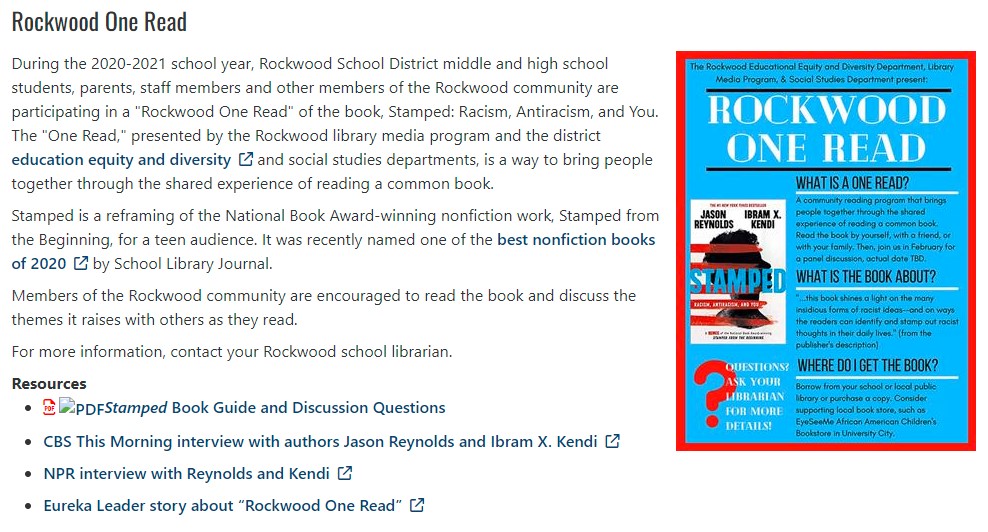
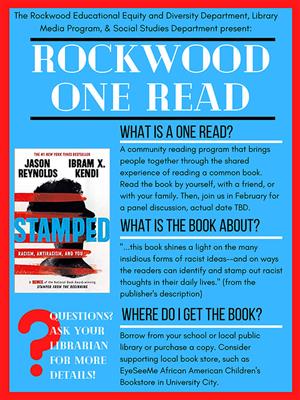
The school district’s website also promotes a document of “discussion questions” for Stamped: Racism, Antiracism, and You. The document explains that the book “takes you on a race journey from then to now, shows you why we feel how we feel, and why the poison of racism lingers.” The following are some questions included in this document:
- What are examples of racism that you’ve encountered or experienced? Referencing the list of racist ideas in Chapter 6, explain why and how your personal experiences with racism are tied to racist ideas that are hundreds of years old.
- As seen with movies like Tarzan, Planet of the Apes, and Rocky, pop culture and media have played a large role in reinforcing racist ideas, whether their stories are overtly racist or are a bit sneakier in their propagation of racist ideas. What current movies, TV shows, and stories promote racist ideas, and how?
- How do race, gender, and sexual orientation intersect and create different barriers for queer women of color?
- After finishing Stamped, how do you feel about the history of racism? What habits and actions can you implement to promote antiracism?
The school district’s website has a document titled “The Beloved Community, 2021” that was created by the district’s Office of Educational Equity and Diversity. The document discusses three “key stakeholders” in pushing equity into the school district. These stakeholders are the “DEI Champions,” “affinity groups,” and “parents.”
The document explains that “DEI Champions” are “staff member representatives from each school building.” The aim for “DEI Champions” is to “increase student equity, access, and opportunity,” create “a framework, common language, and DEI supports for teachers, staff, and students,” and “learning how to provide a culturally responsive environment that is inclusive for all identities.”
The document then explains that “affinity groups help staff members build deep and lasting connections that will ultimately impact relationships, collaboration, and productivity.” The following examples of affinity groups are listed:
- The Rockwood Staff of Color (RSOC) will serve as a safe space for our staff who identify as staff of color.
- The Rockwood LGBTQ+ (R-LGBTQ+) will serve as a safe space for our staff who identify as LGBTQ+.
- Other Affinity Groups – example: Rockwood Male Elementary Teachers.
The document also explains that the “Rockwood Equity Parent Advisory Council” is a stakeholder. The aims for this council are to “ensure we stay on course with the universal equity, opportunity, and access goals” and “promoting, supporting, and informing the school community of DEI resources, initiatives, and opportunities.”
On July 23, 2020, the school district’s Board of Education adopted an equity resolution. The resolution states that the school district “has been and continues to be committed to identifying conscious and unconscious biases and eliminating barriers to educational achievement in our schools.” The resolution also states that the school district “has and will continue to create policies and practices that are rooted in empathy, fairness, and justice.” The resolution then states:
Therefore, be it resolved, on this 23rd day of July 2020, that the District, by and through its Board of Education and Superintendent of Schools, will continue to relentlessly pursue systemic improvements to policies, practices, and programs and continue to provide educational opportunities to ensure that every student and staff member, regardless of race, color, religion, sex, gender identity and expression, sexual orientation, perceived sexual orientation, genetic information, marital status, age, national origin, disability or economic status, can fully realize the District’s mission statement and thrive in the District and beyond.
The school district’s website has a page dedicated to Social Emotional Learning (SEL). The school district promotes CASEL’s five competencies of self-awareness, self-management, social awareness, relationship skills, and responsible decision-making. SEL is now commonly used as a “Trojan Horse” for implementing tenets of Critical Race Theory (CRT), gender ideology, and social justice into the curricula that schools teach children. CASEL has been open with its goal to implement political ideologies into classrooms.

CASEL is an organization that works with school districts throughout the country to use SEL in an effort to push “equity” and “social justice” in education. On July 1, 2020, CASEL promoted “racial justice” in discussing its roadmap for reopening schools during the COVID-19 pandemic. In explaining the importance of the reopening process for schools, the organization stated that “this moment called on all members of our school communities to deepen our social and emotional competencies and create equitable learning environments where all students and adults process, heal, and thrive.” CASEL also published a video in 2020 titled “SEL As a Lever for Equity and Social Justice.”

Stay Informed
